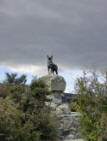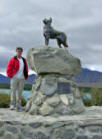|
 |
| ALPINE HEARTLAND & CANTERBURY CHRISTCHURCH South Island NZ |
|
|
 |
| ALPINE HEARTLAND & CANTERBURY CHRISTCHURCH South Island NZ |
|
We stopped at Elephant Rocks briefly to take a look at the unusual rock formations formed as a result of volcanic activity years ago. At Takiroa Rock Shelter, there was 500 year old Maori rock art painted into the bluff, faded considerably from centuries of exposure |
The Canterbury Plains Once covered with forest, the Canterbury Plains are a seemingly endless stretch of flat, fertile farmland. Over hundreds of years the trees as well as the birds were destroyed, leaving a barren, wind blown waste. Now it is covered with wheat fields, crops and grazing sheep. |
 |  |
| The statue of this collie dog is a tribute to the sheepdogs that helped develop the country | ||
Christchurch We were excited about our arrival in Christchurch, where we were to spend 3 days really getting to know the city. We splurged on a great motel room with a spa bath! Our first evening in Christchurch was spent relaxing and watching TV (a rare experience for us) in our room with a Pizza ordered in. Nestled on the Canterbury Plains, Christchurch is pancake flat, save for the Port Hills at its edge. Christchurch is the South Island's biggest city of 340,000 people (1/3 the population of the South Island). The city is a pin-neat, arty reflection of British heritage with restored neo-Gothic buildings and churches. We began our tour in the heart of the city, Cathedral Square, where the Wizard, a local eccentric who is now a national institution entertains the crowds from his stepladder.
We stopped at New Regent Street, a interesting area comprised of Spanish style architecture. (Note the bears hanging from the window above The Teddy Bear Store) |
From Cathedral Square in the center of the city there are many examples of Anglican Gothic architecture. | |
 Also on the agenda was the Art's Center, a group of Gothic buildings (formerly Canterbury University) that is now home to funky crafty shops and markets. Also on the agenda was the Art's Center, a group of Gothic buildings (formerly Canterbury University) that is now home to funky crafty shops and markets. |  The Botanical Gardens, adjacent to the Museum, was a nice place to sit and relax by the fountain. | |
Banks Peninsula Wanting to take in the beauty of the surrounding countryside we took a drive around Banks Peninsula. Banks Peninsula is the result of violent eruptions of three volcanoes. Starting at the Summit Road we drove high into the Port Hills where there were spectacular views of the rugged scenery, stark brown hills of the craters, and many rural bays and beaches below. The entire area was a haven for trekkers and bikers with trails everywhere. |  |  | ||
 |  | Eventually we reached the top where the gondola runs, 500 m above sea level with magical 360 deg views of the city, harbour, Southern Alps and Canterbury Plains. |  |  |
| ||||
We returned to our room at the Northcote Motel and I had another bath...I think that was #5 since we checked in! That evening we took in the internationally acclaimed Antarctic Centre. 70% of the world's scientists fly to Antarctica from the International Antarctic Centre. Next day we headed down the Kaikoura Coast, heading back to Picton to complete our circumnavigation. From the gentle farmland north of Christchurch the transition to the Kaikoura coastline is dramatic. Grassy hills give way to rugged mountains that soar above the highway paralleling the ocean. | ||||
| Where Nature Still Rules | ||||

| This area is home to all kinds of wildlife, both on land and in the sea. The sign on the left displays the profile of the Pukeko, a flightless bird that hangs out along the roadsides. Of course, the Tui (Beer Bird named after the local NZ Beer) is a common sight. We also saw some Waka (pictured left) that look something like chickens. | |||
 This area of the South Island has always been linked to the sea. Reminders of whaling stations still linger along the coastline. It was evident that Crayfish are an abundant harvest there as we saw lots of locals gathering the NZ Lobster among the rocks. Just before Kaikoura, we stopped by the road to watch hundreds of Hector Dolphins frolicking, putting on a great show with their summersaults and flips out of the water. Hector Dolphins are the smallest breed of their species. This area of the South Island has always been linked to the sea. Reminders of whaling stations still linger along the coastline. It was evident that Crayfish are an abundant harvest there as we saw lots of locals gathering the NZ Lobster among the rocks. Just before Kaikoura, we stopped by the road to watch hundreds of Hector Dolphins frolicking, putting on a great show with their summersaults and flips out of the water. Hector Dolphins are the smallest breed of their species. | 
| |||
 Kaikoura is a beautiful little town with its spectacular backdrop of mountains. The waters of Kaikoura are known for the marine wildlife which includes colonies of seals, commercial whale watching, swimming with the dolphins, snorkeling, and so on. We walked among the rocks investigating the tidal pools along the beach. Kaikoura is a beautiful little town with its spectacular backdrop of mountains. The waters of Kaikoura are known for the marine wildlife which includes colonies of seals, commercial whale watching, swimming with the dolphins, snorkeling, and so on. We walked among the rocks investigating the tidal pools along the beach. |
||||
 | Continuing the drive down the coast toward Blenheim, there was no disputing that Marlborough is New Zealand's wine capital. Not only is more than half the country's wine produced here but the amount exported is considerably higher than 50%. The vineyards are abundant throughout the country. Toward Picton, the farmland reigned the country as the familiar Holstein once again outnumbered the population. We checked back into our Villa Backpackers room and relaxed, ready for our morning departure to head back to Whangarei. |
 | Our ferry ride back to the North Island marked the end of our wonderful journey through the South Island. We took the interior highway back to Auckland, spending the night at Hastings in a Holiday Camp beside a race track. It was cool waking up to the sound of pounding hoofs as the horses were out for an early morning workout. |